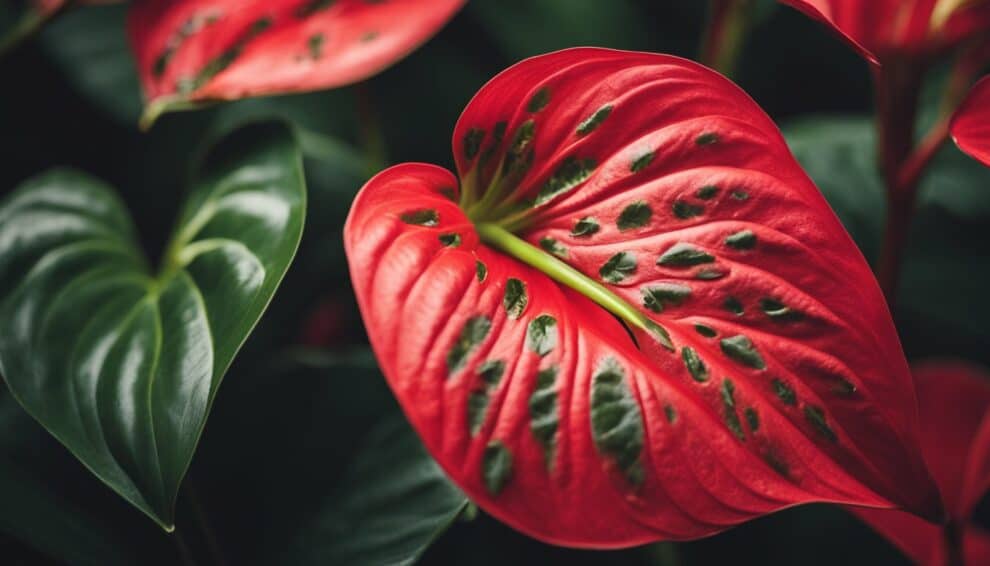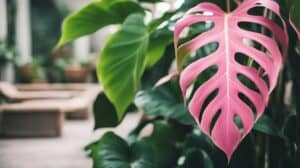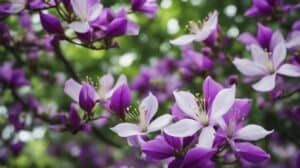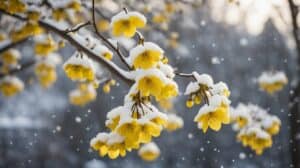Anthurium Scherzerianum, commonly known as the Flamingo Flower, is a tropical plant with a fiery elegance that has captured the hearts of many plant enthusiasts.
Native to Colombia and Ecuador, this plant is a popular houseplant due to its stunning appearance and easy care.
The Flamingo Flower is a member of the Araceae family, which includes other popular houseplants such as the Peace Lily and Philodendron.

One of the most striking features of the Flamingo Flower is its vibrant red, heart-shaped spathes that resemble the feathers of a flamingo.
These spathes are actually modified leaves that surround the plant’s tiny yellow flowers.
The Flamingo Flower also has glossy, dark green leaves that add to its overall beauty.
With proper care, this plant can bloom all year round, making it a great addition to any indoor garden.
Despite its delicate appearance, the Flamingo Flower is a hardy plant that can thrive in a variety of conditions.
It prefers bright, indirect light and well-draining soil.
It also enjoys high humidity, which can be achieved through regular misting or by placing a tray of water near the plant.
With its stunning beauty and easy care, the Flamingo Flower is a must-have for any plant lover.
Anthurium Scherzerianum Origins

Historical Background
Anthurium Scherzerianum, also known as the Flamingo Flower, is a tropical plant that belongs to the Araceae family.
It was first discovered in the late 1800s by a botanist named Heinrich Wilhelm Schott, who named the plant after his friend, Baron von Scherzer.
The plant is native to Central and South America, and is widely cultivated for its beautiful flowers.
Native Habitat
Anthurium Scherzerianum is native to the rainforests of Central and South America, where it grows in the understory of the forest.
The plant prefers warm and humid conditions, and can be found growing in the wild in countries such as Colombia, Ecuador, and Peru.
In its natural habitat, Anthurium Scherzerianum grows as an epiphyte, which means that it grows on other plants, such as trees, without harming them.
The plant has adapted to this lifestyle by developing aerial roots that allow it to absorb moisture and nutrients from the air.
Overall, Anthurium Scherzerianum is a fascinating plant with a rich history and a unique native habitat.
Its fiery elegance and tropical beauty make it a popular choice for indoor and outdoor gardens alike.
Cultivation and Care

Planting Guidelines
Anthurium Scherzerianum, commonly known as the Flamingo Flower, is a tropical plant that requires a specific set of conditions to thrive.
When planting, it is essential to use well-draining soil that is rich in organic matter.
The plant prefers a slightly acidic soil with a pH between 5.5 and 6.5.
It is recommended to plant the Anthurium Scherzerianum in a pot with drainage holes to prevent waterlogging.
The pot should be filled with soil, leaving enough space for the plant’s roots.
The plant should be planted at the same depth as it was in its previous pot.
Watering and Feeding
The Anthurium Scherzerianum requires consistent watering to maintain healthy growth.
The plant should be watered when the top inch of soil is dry to the touch.
Overwatering can lead to root rot, while underwatering can cause the plant to wilt.
The plant should be fertilized every two weeks during the growing season with a balanced fertilizer.
During the dormant season, fertilization can be reduced to once a month.
Light and Temperature Requirements
The Anthurium Scherzerianum prefers bright, indirect light. Direct sunlight can scorch the leaves, while low light can cause the plant to stop flowering.
The ideal temperature range for the plant is between 60°F and 90°F (15°C and 32°C). Temperatures below 50°F (10°C) can cause damage to the plant.
It is important to avoid placing the Anthurium Scherzerianum near drafts or air conditioning vents, as the plant prefers a humid environment.
The plant can benefit from misting or placing a tray of water near the plant to increase humidity.
Overall, with proper care and attention, the Anthurium Scherzerianum can thrive and add a touch of fiery elegance to any home or garden.
Aesthetic Appeal and Uses
Flower Characteristics
Anthurium Scherzerianum, commonly known as the Flamingo Flower, is a tropical plant with stunning flowers that come in a variety of colors, including red, pink, orange, and white.
The flowers have a unique shape, with a spadix (the long, thin stem in the center of the flower) surrounded by a colorful, heart-shaped bract.
The leaves are glossy and dark green, adding to the plant’s overall attractiveness.
The Flamingo Flower is a popular choice for indoor plants, as it can thrive in low light conditions and is relatively easy to care for.
It is also a favorite among flower enthusiasts and collectors due to its striking appearance.
Decorative Uses
The Flamingo Flower’s aesthetic appeal makes it a popular choice for decorative purposes.
It can be used as a centerpiece in floral arrangements or as a standalone plant in a decorative pot.
The plant’s unique flowers are often used in wedding bouquets, adding a touch of elegance and sophistication to the ceremony.
In addition to its decorative uses, the Flamingo Flower has also been used for medicinal purposes in traditional medicine.
The plant has been known to have anti-inflammatory and antibacterial properties, making it a valuable resource in treating various ailments.
Overall, the Flamingo Flower’s fiery elegance and versatility make it a popular choice for both decorative and medicinal purposes.
Its unique characteristics and ease of care make it an excellent addition to any home or garden.
Propagation and Repotting

Propagation Techniques
Anthurium Scherzerianum can be propagated through division or stem cuttings.
To propagate through division, gently remove the plant from its pot and separate the roots into individual clumps with a clean, sharp knife.
Each clump should have at least one healthy stem and a few roots. Plant each clump in a new pot with fresh potting soil and water thoroughly.
To propagate through stem cuttings, select a healthy stem with at least two leaves and cut it just below a node.
Remove the lower leaves and dip the cut end in rooting hormone. Plant the cutting in a pot with fresh potting soil and water thoroughly.
Cover the pot with a plastic bag to create a humid environment and keep it in a bright, warm spot.
When and How to Repot
Anthurium Scherzerianum should be repotted every 1-2 years to ensure healthy growth.
Signs that the plant needs repotting include roots growing out of the drainage holes, the plant becoming top-heavy, or the soil becoming compacted.
To repot, gently remove the plant from its pot and gently loosen the roots.
Choose a new pot that is 1-2 inches larger in diameter than the old pot and fill it with fresh potting soil.
Place the plant in the new pot and fill in around the roots with soil, pressing it down gently. Water thoroughly and place the plant in a bright, warm spot.
When repotting, it’s important to avoid burying the plant too deeply. The top of the root ball should be level with the soil surface.
Overwatering after repotting can also cause root rot, so it’s important to let the soil dry out slightly between waterings.
Frequently Asked Questions

How do I care for my Anthurium Scherzerianum to ensure it blooms beautifully?
To keep your Anthurium Scherzerianum blooming beautifully, it is important to provide it with the right amount of light, water, and nutrients.
The plant prefers bright, indirect light, so placing it near a window that receives filtered sunlight is ideal.
Water the plant when the top inch of soil feels dry to the touch, and be sure not to overwater as this can lead to root rot.
Fertilize the plant every two weeks during the growing season with a balanced fertilizer.
What are the ideal lighting conditions for a Flamingo Flower?
Anthurium Scherzerianum prefers bright, indirect light.
Direct sunlight can scorch the plant’s leaves, so it is best to place it near a window that receives filtered sunlight.
Can you provide tips for watering and feeding my Anthurium to keep it thriving?
Water your Anthurium Scherzerianum when the top inch of soil feels dry to the touch. Be sure not to overwater as this can lead to root rot.
Fertilize the plant every two weeks during the growing season with a balanced fertilizer.
What common pests should I look out for, and how do I protect my plant?
Common pests that can affect Anthurium Scherzerianum include spider mites, mealybugs, and scale insects.
To protect your plant, inspect it regularly for signs of infestation, such as webbing or sticky residue on the leaves.
If you notice any pests, treat the plant with an insecticidal soap or neem oil.
How often should I repot my Flamingo Flower, and what soil mix is best?
Anthurium Scherzerianum should be repotted every two to three years, or when the plant has outgrown its container.
Use a well-draining soil mix that is rich in organic matter, such as a mix of peat moss, perlite, and orchid bark.
Why are the leaves on my Anthurium turning yellow, and how can I fix it?
Yellowing leaves on Anthurium Scherzerianum can be a sign of overwatering, underwatering, or exposure to direct sunlight.
To fix the issue, adjust your watering schedule, move the plant to a location with filtered sunlight, or check the soil for signs of root rot.














